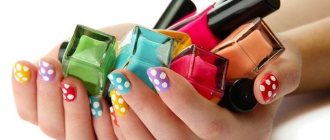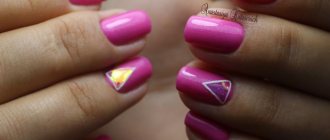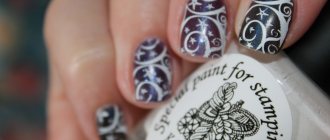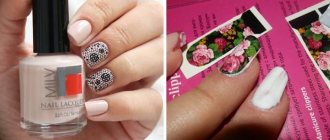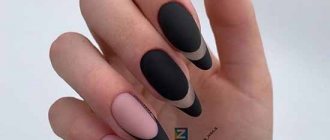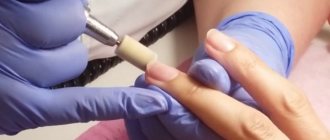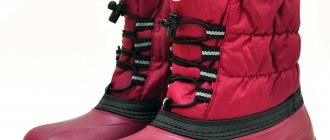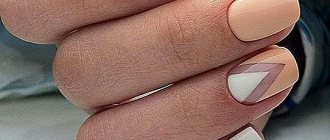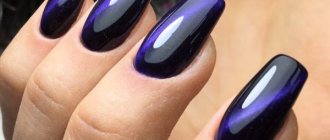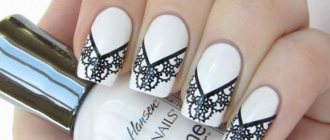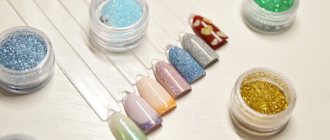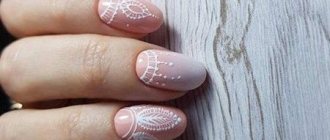Updated: 04/23/2021 11:35:07
Expert: Ekaterina Alekseevna Savitskaya
Nail care is one of the daily concerns of a modern woman. Conventional decorative coatings, such as simple varnishes, quickly lose their aesthetic appearance and must be washed off and reapplied frequently. But products like gel polish and shellac allow you to create a long-lasting manicure and forget about the need to care for your nails for a long time. Journalists from expertology.ru talked to nail art experts and learned all about shellac - what it is, how it differs from varnish and gel, how to apply it, what its advantages and disadvantages are.
Shellac – what is it, how does it differ from other decorative cosmetics
Shellac is a unique nail care product that was invented and patented by CND (Creative Nail Design) in 2010. This drug is a kind of hybrid or intermediate between classic polish and gel polish. At that time, Shellac made a splash in the world of the nail industry and immediately gained great popularity. The drug became an excellent alternative to classic varnishes, which stayed on the nails for two to three days.
There is an opinion that preparations labeled Shellac contain an organic polymer of the same name, used in the production of industrial varnishes, insulating materials, and in the furniture and footwear industries. However, this is not true; if you study the packaging of such a varnish and look at the composition, you will not be able to find any mention of shellac resin in it.
It is not appropriate to compare shellac and regular classic nail polish, since these are completely different cosmetics. The varnish hardens in the air, and a product called Shellac dries under the influence of UV rays.
But there are common features between shellac and gel polish, since nail art using these products will require a drying lamp. There are fundamental differences between these drugs:
- Gel polish is more viscous than Shellac. Therefore, the first remedy can be used to correct the shape and length of nails (including extensions). And the second product is simply a very durable decorative coating.
- Shellac can be removed using a special liquid. And gel polish can only be removed mechanically (by filing).
- Shellac is not often, but it is still necessary to completely wash off and do nail art again. And the gel can be applied rarely and worn on the nails for any time, with periodic correction of the coating.
- Today, the original shellac is a product of the already mentioned SND brand. However, this term has become a household word; it is also included in the names of products from other companies. For example, on sale you can find cosmetics for nail art Shellac Bluesky, AllShellac Premier.
Is it worth applying shellac – the advantages of the product as a decorative coating for nail art
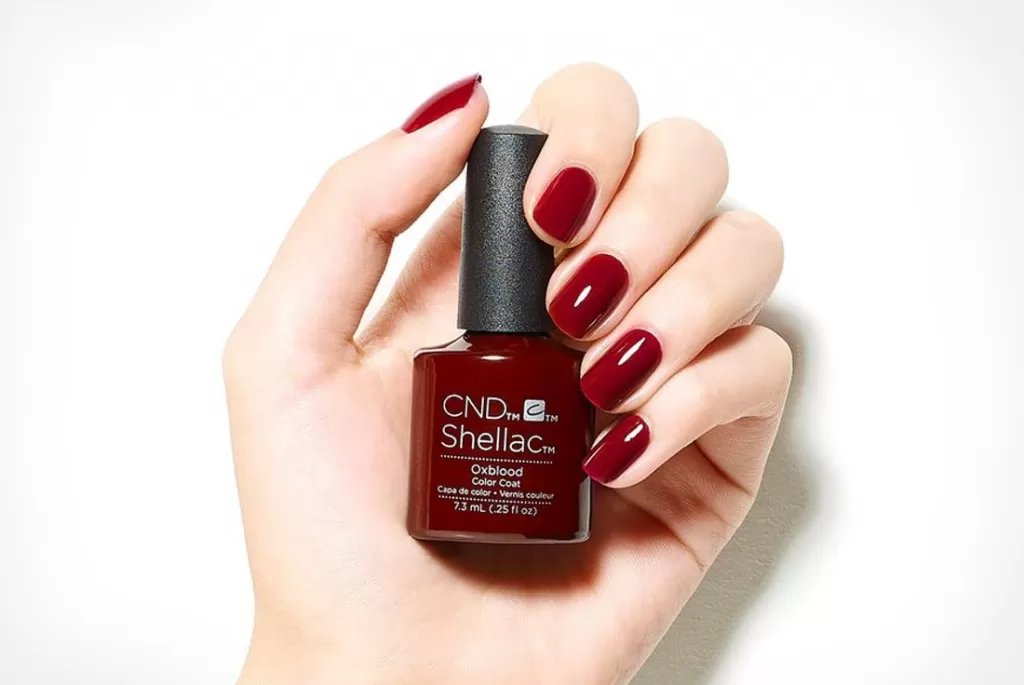
Experts note that a product such as shellac has many advantages over other manicure preparations:
- Full color saturation. If you apply the varnish, its shade fully corresponds to what is stated on the label.
- A very large assortment of colors and shades of shellac, a varied palette of colors, which is worked on by high-class designers. If you plan to apply this product, you have over 250 options to choose from. Moreover, varnishes can be applied solo or mixed, obtaining unusual secondary and tertiary colors.
- Soft and comfortable texture. Shellac is very easy to apply, it does not smear and lies smoothly on the surface. It does not weigh down the nail plates and is comfortable to “wear.” Due to the fact that shellac contains a large number of oligomers, it does not evaporate or dry out, even if the process of performing nail art is delayed. Shellac hardens only during polymerization with the participation of ultraviolet radiation, forming a hard and durable film on the surface.
- Versatility of use. Shellac can be applied to create a one-color manicure. Or use this tool to create original drawings of any degree of complexity, to bring unique designs to life.
- Increased durability of the coating. Shellac can be applied once every two or even three weeks, as it is resistant to chemical and mechanical influences. You can safely and without restrictions do housework, take baths, visit the beach and swim in reservoirs. The coating will not fade in the sun, peel, wear off or chip; it will remain the same as immediately after application. Manicure and pedicure always have a neat, well-groomed appearance, and a woman does not need frequent nail care. However, experts note that shellac can stay on nails for less time than expected. This may be due to the unsatisfactory condition of the nail plates, lame technique and insufficient skill in performing nail art, poor quality of the material that can be applied in salons with a dubious reputation, and frequent hand contact with chemicals.
- If you apply shellac in a thin layer, as recommended by the manufacturer, then you can use the product quite economically. The volume of one standard bottle of varnish from the SND company is 7.3 milliliters. Nail art masters assure that this amount of product will be enough for 15 or even 20 procedures. That is, for 5-6 months, which will allow you to save money even with a fairly high cost of cosmetics.
- There is no persistent unpleasant odor while you apply shellac, which makes the procedure comfortable.
- The time during which you will have to apply the decorative coating is only 30-40 minutes. This makes it possible to make long-lasting nail art in a salon or nail bar, even during your lunch break at work. At the same time, immediately after the procedure, you have the opportunity to begin your daily activities without fear of touching and smearing the decorative coating that has not completely dried, as was the case with traditional varnishes.
- If you apply shellac, it will not interfere with the natural growth of the nail plate. The drug has a safe composition, there are no formaldehydes, toluene, dibutyl phthalate and other harmful components. Thanks to this, the manufacturer was able to declare the shellac composition as “7 Free”. The drug does not cause allergic reactions or other complications. Some experts claim that shellac protects fabrics from the negative effects of external factors, which helps improve their condition and structure.
- Shellac can be applied without any age or health restrictions. Even high school students use this product to give their nails a neat and well-groomed look. There are no restrictions on the use of shellac for expectant mothers and breastfeeding women. Shellac allows women of any profession and status to always look well-groomed, stylish, with a minimum of effort and spending a minimum of time.
- You can apply shellac regularly. As soon as the outdated coating is removed, you can do a new manicure (but experts still recommend taking a short break of a few days or a week).
- You can apply and wash off shellac not only in a beauty salon, but also at home. This allows you to save on hand care.
If you have previously used acrylic extensions or modeling gel, then you will note another advantage of shellac - the price of this decorative cosmetics product for nail art. Compared to the price of other permanent nail art preparations, applying shellac is cheaper.
Shellac is a new word in manicure
Shellac is an innovative product that combines varnish and gel. Recently, it has become extremely popular among women of different ages.
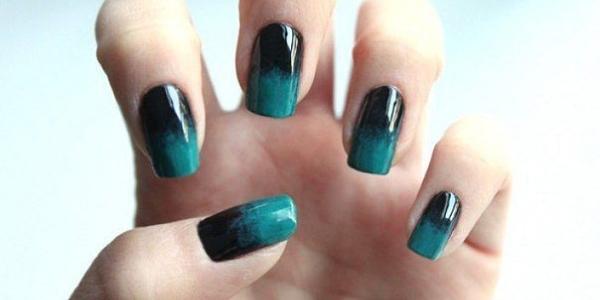
- manicure using shellac looks more natural, neat and well-groomed.
- Covering your nails with Shellac is much cheaper than getting acrylic extensions.
- Shellac gel polish allows you to grow your nails and significantly improve their condition.
- The secrets of how to make a manicure from newspaper are revealed in the article.
- Do you want to know what to do if your nails are peeling? You can find the answers here.
To apply shellac or not – the disadvantages of a permanent nail art product
Before you decide to buy shellac and use it for manicure, it would be a good idea to learn about the disadvantages of this drug. There are not many of them, but they still exist:
- Shellac can only be applied with a special LED lamp. Without it, the product simply will not harden. Buying a lamp is an additional expense. Other accessories will also be required, which we will also discuss in this article.
- Performing a manicure at home requires certain skills and dexterity. Therefore, before applying permanent shellac, you need to practice doing nail art using ordinary decorative varnishes.
- The base that needs to be applied to the nails before applying the decorative coating is acidic. This product slightly lifts the scales of the nail plate, providing the desired level of adhesion. If your nails are prone to dryness, the polish may begin to crack.
- To remove the decorative coating, you will need an acetone-containing product, which is not very good for the nail plates. Shellac itself is safe, but the drug used to remove it from nails is questionable.
- During the process of applying manicure, the preparation, although slowly, thickens under the influence of light. Many women complain that they only managed to use half of the bottle of varnish, and the second half can no longer be applied, since it is not flexible enough.
- The cost of shellacs is not as low as we would like. In a specialized store, the average price of one bottle of gel is more than 500-1000 rubles. If you carry out the procedure in a beauty salon or with a private manicurist, it will also cost a lot. You can find products on sale at a relatively low cost - about 200 rubles. But experts do not recommend applying shellac from unknown manufacturers, as you can get a poor-quality manicure and also cause harm to the nail plates.
- Due to the high popularity and relatively high cost of branded shellac, it is often counterfeited. Such drugs produced in China and purchased through the Aliexpress service (or elsewhere) can cause chemical burns. If you buy cosmetics to perform a manicure at home yourself, you can order the products on the official website or from official representatives without fear of counterfeiting. There is nothing complicated here, it's just a matter of price. What if a manicure with shellac is done in a beauty salon? You cannot be sure that the establishment’s employees purchase truly high-quality original drugs that can be applied without fear.
As you can see, shellac has some disadvantages, although they are mostly minor. But the question arises, why do so many women around the world choose this particular product in order to get a long-lasting and beautiful manicure? Especially in a situation where there is a safer and more profitable alternative - gel polish or acrylic coating. There is no doubt that shellac is better than traditional nail polish. But otherwise, it is inferior in all respects to gel polish, and its widespread use is justified by several reasons. It is convenient and profitable for salons to use shellac. Performing a manicure takes little time, only half an hour instead of the two to two and a half hours that are spent on applying gel polish. Therefore, masters can accept more clients during the day. Shellac is also less durable than the alternative preparation; it adheres well only to perfectly smooth and healthy nails. In addition, the nails grow back, exposing the unvarnished surface at the base. Accordingly, many clients are forced to come back frequently for corrections, as well as manicure removal and a new one. All this brings good income to beauty salons, so they work mainly with shellac, recommending it to clients as the preferred option.
How to do
Service in salons is not cheap. But you can apply it yourself at home. To do this, you must purchase all the materials and tools described below.
What is shellac manicure - secrets of popularity
From the traditional professional product, shellac took rich shades, shine and ease of application. All this allows you to quickly decorate your fingers and do it efficiently. It gained popularity and universal love due to the fact that:
- does not require significant preparation of the plate: you can do without a primer;
- firmly attached to the nail, but does not harm it;
- can be removed without cutting;
- You can apply a new coating immediately after removing the old one.
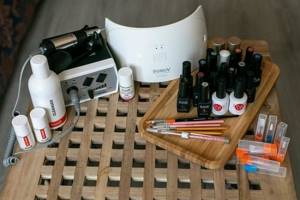
When you should not apply shellac - contraindications

The results of numerous studies indicate that applying shellac is not harmful to health. There are no contraindications to its use. With the exception of cases of diseases of the nail plates. For example, you should not use varnish if you have untreated nail fungus.
It is also not recommended to use shellac as a decorative coating if you have thin, brittle, weakened, flat, springboard-shaped, broken, bumpy, or uneven nails. In this case, quick chipping of the surface cannot be avoided; the manicure will last 7-10 days. This is due to the fact that shellac has a too liquid base, which is not capable of perfectly leveling out all relief defects and creating a perfectly flat surface for applying decorative layers. To achieve a high-quality manicure, it is recommended to replace shellac with viscous gel polish.
What does perfect shellac nail polish mean?
This is a perfectly applied product. And to achieve this, you need to know the sequence of the procedure, as well as what materials are needed.
The basis of the quality process are:
- following hygiene advice;
- grinding the plate and making an even shape using a nail file;
- a thin layer of base, also placed at the end;
- drying only in a special lamp with a power of at least 36 W;
- brushing exclusively from top to bottom;
- double use of base layer, each time drying under ultraviolet light.
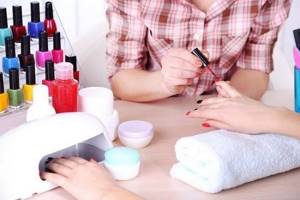
What you need to apply shellac at home
To be able to apply the products yourself, without visiting a beauty salon or a private specialist, you need to purchase the following kit:
- Everything you need for hygienic or decorative manicure. These are scissors, files, accessories for removing cuticles, etc.
- Varnishes labeled “Shellac” that you intend to apply. You can select the required colors in the catalog of any online store of manicure products. But it’s still better to “try on” the shades of varnishes in person. In regular stores there are special palettes that allow you to apply an artificial nail covered with a certain color of varnish to your fingers and see if this option suits you.
- Special LED lamp (fluorescent, LED, CCFL ultraviolet lamp). No matter how much it costs, the purchase is necessary; without it, applying Shellac is useless. Cheaper items can be found on the websites of large online stores. It is advisable to buy a device that emits UV waves in a wide range - from 270 to 400 nm. This will allow you to work with any shellacs and gel polishes from different manufacturers.
- A product for removing shellac from nails, as well as several nail files with varying degrees of abrasiveness, and a set of orange sticks.
- Lint-free wipes and degreaser to treat the last layer.
- A variety of additional tools for the designs you plan to create. These can be rhinestones, glitters, powders.
- Since manicure needs to be applied in good lighting, you need to take care of purchasing not only an LED lamp, but also a tabletop fluorescent lighting fixture.
Pros of shellac
- can be used on any length of nails . And due to the fact that the coating strengthens the nail, it begins to grow faster.
- lasts about 2-3 weeks, while no chips or scratches form on the surface. The coating is smooth, shiny and uniform. Household chemicals do not affect the wear time of the coating.
- It can be easily and quickly removed even without visiting a salon. You just need to buy a special liquid.
- does no harm . No formaldehyde is used in its production. Therefore, shellac can be used by pregnant women and those who are susceptible to allergies.
- large palette of colors . There are about 250 shades of gel polishes.
To apply shellac, you need to choose the right lamp
To be sure that the drying lamp is suitable for performing manicure, you need to make sure that the wavelength is sufficient to start the polymerization process of the decorative coating. There should be special markings on the shellac packaging indicating what type of lamp should be used:
- UV/LED - this label indicates that this is a universal varnish that can be applied with any drying lamp.
- UV – a lamp with short or mid-range ultraviolet waves must be used. To apply Shellac, devices with wavelengths from 280 to 370 nm, fluorescent or CCFL type, are suitable.
- LED – this mark indicates that you need to use an LED lamp with a wavelength of 380-400 nm. You can use other types of devices, but in this case, shellac polymerization will take much longer.
Sequence of nail art - how to apply shellac
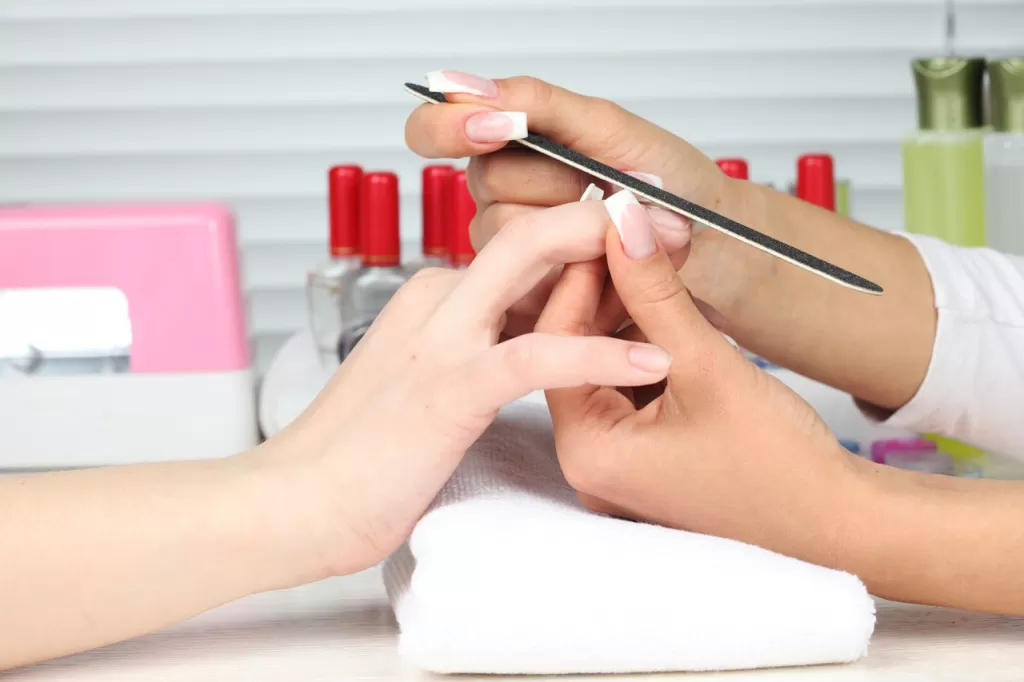
The procedure for performing a manicure does not pose any particular difficulties; over time, you will learn how to apply shellac quickly and efficiently:
- The first stage is preparatory
. Nails are cleaned, their shape and length are adjusted, and the cuticle is removed. It is important to pay attention to the thorough removal of the cuticle, since if persistent varnish gets on it, the coating will most likely peel off and crack very quickly. To prevent this, you can use Cuticle Eraser from CND or another similar product. A more economical way to remove cuticles is to use a trim manicure. To polish the nail plate, which is performed several times a month, a buff is used. Then the nails need to be cleaned of dust and treated with an antiseptic. To degrease the surface, special compounds are also used; dehydrate can be used to remove excess moisture.
- Nails are coated with a special manicure primer
. Using a primer helps protect nails, improve adhesion (adhesion) of the coating to the surface, and increase the durability of the manicure.
- Applying the base
, preferably on a rubber base. Nail art specialists who believe that in a manicure you need to use products from the same company that are ideally combined with each other, recommend using Base Coat from CND. But you can replace this drug with another similar product, for example, the base from Color Couture Entity One, which has healing properties, strengthens tissue, and additionally protects nails from the negative effects of pigments. The layer of the drug should be as thin as possible. Drying under a lamp and fixing under a lamp at this stage is mandatory.
- Now you need to apply the first layer of decorative coating
. This layer must be dried, it should also be as thin as possible. Polymerization (hardening) of shellac begins using a drying lamp. Many women are interested in how long to keep their hands under the lamp. The drying time of the product depends on several factors - the type of lamp, the length of the emitted waves, the chemical composition of the varnish, and the thickness of the coating layer. The rate of polymerization may even depend on the distance between the light source and the nails. Also, its color plays an important role in the drying process of the drug. For example, Shellac with a high degree of pigmentation takes longer to harden than those that have less intense color. This means that black or red shellac will take longer to harden than, for example, white or beige. The average drying time for the coating is 30-60 seconds under an LED lamp and 2-8 minutes under a CCFL lamp.
- It is necessary to consistently apply the required number of layers of shellac
, each of which is dried under a lamp. Depending on the type of product, density and intensity of pigmentation, it may be necessary to perform from two to five layers. After the last layer is done, a special preparation must be applied to the nails. This product has degreasing properties; it removes the sticky dispersion layer that forms on the surface of the film. Experts recommend using a clinser for this purpose. But, as a last resort, 99% isopropyl alcohol will do.
- Need to apply sealer
, which is a top coat for shellac. In this case, this is a layer that may be thicker than the main ones. To create a finish, you can use a product from the line of cosmetics from the CND brand - Top Coat.
- Experts advise in the first few days after a manicure using shellac avoid prolonged water procedures
. This recommendation is justified by the fact that the final hardening of shellac continues for another two days after the nail art procedure.
- After use, the shellac bottle must be tightly closed.
and store exclusively in a dark place. The fact is that sunlight also contains ultraviolet waves. Of course, polymerization of the product under the influence of ordinary light takes a very long time, but it can curl and change its texture and properties.
How to apply shellac - popular methods of manicure
Using this product for nail decoration, you can embody any ideas and use different manicure techniques:
- Nail art in French style. Light “smiles” on the tips of the nails can be done with white, milky, soft pink or cream varnish. CND brand products, for example, Cream Puff or Stidio White, are ideal for this technique. You can use artistic painting, bouillons, and rhinestones as additional decorative elements.
- Stamping or stamping. In this case, an elegant design can be applied under the top layer using a special varnish. For stamping, you will need not only shellac, but also metal plates that transfer the pattern to the surface of the nails.
- Lunar nail art. A type of French, in the technique of which the crescent is located not at the tip of the nail, but closer to the cuticle. And in most cases, it is not light varnish that is used, but cosmetics with increased pigmentation, that is, colored ones.
- Ombre technique or gradient application of shellac. In this case, varnish of one color is applied at the base of the nail, varnish of the second color is applied at the tip of the plate. In the middle you can use a third shade. And then the shades are mixed with a very thin brush, creating the effect of a smooth flow of one color into another. You can do several layers to enhance the ombre effect.
- Water manicure technique combined with shellac. To create such fashionable water patterns, you need to apply the first layer of shellac, dry it, and then dip the nail in an aqueous solution of paints of the selected colors. Fingers must be pre-treated with cream or the skin isolated with tape. As a result, colorful abstract patterns will appear on the surface of the marigolds. After this, you can apply a finishing layer of transparent product.
These are not all the techniques that can be implemented using or based on shellac. Having mastered the basics of using this product, you can begin to experiment with your own nail decoration options.
How to remove shellac from the surface of nail plates
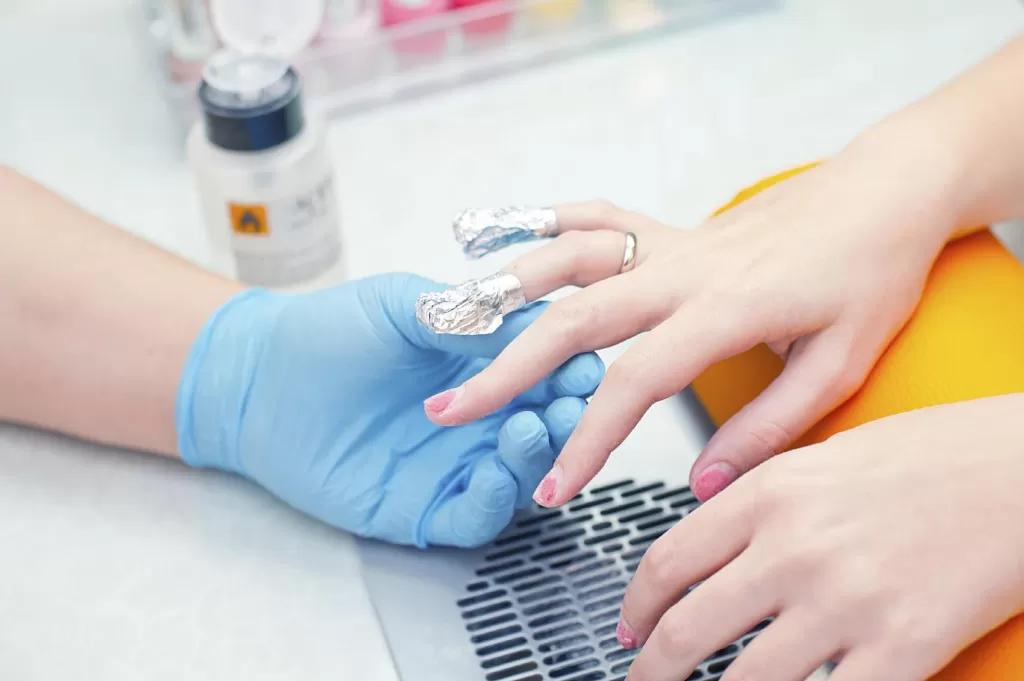
Shellac is removed from nails using a special acetone-based solution. The company employees who developed the formula of the drug did not want to scare away clients and manicurists, so the fact that Shellac remover contains acetone, which is relatively harmful to nails, is not advertised.
The procedure for removing stubborn varnish is simple:
- Wash your hands thoroughly.
- Prepare ten adhesive-based sponges, which are designed specifically for gentle removal of shellac. Instead of sponges, you can use cotton pads (cotton wool) and foil. Or cotton pads and special nail pads for additional fixation.
- Soak the discs with a special solvent. It is optimal to use products from the CND company, which are called Product Remover or other products with similar properties.
- Wrap the sponges around the nails and fingertips so that the part soaked in the solvent comes into contact only with the nail plate and is fixed with a sticky surface. Leave the sponges on your nails for 10 minutes.
- After removing the solvent-soaked bandages, you need to clean your nails of large polish residues using an orange stick, which is not so hard as to harm the tissues of your hands.
- If there are slight shellac residues on your nails, remove them by wiping the contaminated surfaces with a cotton pad soaked in solvent.
- Wash your hands, treat cuticles and nails with caring oil. After some time, you need to apply a moisturizing or restoring cream to your hands.
- What to do if you don’t have a special solution at hand to remove durable decorative coating? Experts advise going to a beauty salon where you can have your manicure corrected or completely wash off your shellac. Another option is to use standard acetone-containing solvents. You just need to take into account that it will take a lot of time to dissolve the dense film of the polymer coating.
- Is it possible to remove shellac using hardware? Manicurists say that this is possible, but it is not advisable to carry out such a procedure. Due to the peculiarities of the composition, the cutter gets stuck in the material, and the effectiveness of the procedure is low. In addition, using mechanical methods to remove the coating is dangerous for nails. There is a high probability of sawing through the nail plate, since the coating layer is not thick enough and it itself is fragile. Hardware manicure removal is more suitable if a thicker gel polish was used. However, you can use manual mechanical action and files with an abrasive coating. At least in order to remove the bulk of the polymer material from the nails.
Manicurists strongly advise against using this method of manicure removal, such as an acetone bath. If you use this particular method, you can damage not only your nails, but also the skin of your fingers.
Step by step application of shellac manicure
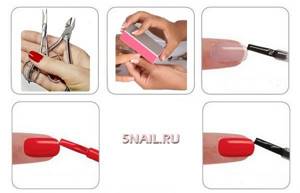
- Before the procedure, a hygienic manicure is performed in the usual way: the cuticle is removed and the nails are shaped. If the shape of your nails suits you, you still need to file them a little. Before applying shellac, a dry manicure with two-time treatment with an antibacterial agent is performed in a salon or by an experienced master.
- Polishing nails with a buff. Polishing should be done once or twice a month during the next nail covering. The buff should be held along the nail plate and polished with light longitudinal movements. After the procedure, you need to remove dust particles with a brush.
- Degreasing the nail surface. Such processing is mandatory. If there is no special product (for example Scrub Fresh), then use alcohol or nail polish remover. This is better than nothing, but after such treatment, chipping and peeling are possible.
- Application of primer (bondex). For shellac, this is an optional, but highly desirable operation. The primer ensures adhesion of the nail surface to the underlying layers of varnish. Choose a primer without toluene and formaldehyde: after all, this is the layer in direct contact with the body. After applying this product, treatment under a UV lamp is not required. But if your nails look glossy or damp, then you need to remove excess liquid. They can cause peeling.
- Applying the base. When applying the Base Coat, you need to hold the brush almost parallel to the nail. This makes it possible to apply the thinnest layer possible. You need to cover the entire nail surface, from the root of the cuticle to the tips of the nail. And then “seal” the tip, that is, paint over its end with the same thin layer. The base requires curing under a UV lamp at 36 W for 1 minute. Rubber-based basecoats have proven themselves to be excellent. They make the nail plate absolutely smooth and ready to be coated with colored varnish. After the base coat, there is no need to wash off the sticky dispersion.
- Application of colored shellac. The technique for applying colored varnish is the same as for the base. A thin layer of colored shellac is applied with a thin brush parallel to the surface of the nail. Then the end is painted over, and the nail is sent under a UV lamp for 10 seconds. When you have finished covering all the fingers on your hand, hold the brush under the lamp for another 1 minute to dry completely. In this way, apply two layers to all fingers and cure the resulting coating under UV light.
- Applying a protective layer. The fixing layer (Top Coat) protects the manicure from scratches, chips, and abrasions. When applying it, be especially careful: if you get the fixative on the cuticle or skin, it can “raise” the already finished color layer. A single-layer coating is performed on both hands, the tips of the nails are carefully “sealed” and the brushes are sent one by one to be treated under a lamp for 2 minutes. It is important to remove the sticky layer from your nails with a degreaser. This is done after the top coat has completely cured.
- Completing the manicure. The final touch is treating the cuticle with a special caring oil. This could be CND Solar, Milv or another product with vitamins, oils, etc.
How long does shellac last?
The average time that a shellac manicure will remain intact on your nails is approximately three weeks. How long you carry a specific coating made by you or an experienced craftsman depends on:
- Techniques and skills of manicure,
- Quality of materials,
- Regular nail care.
Removing shellac
There are at least two ways to remove shellac from nails: civilized and not so civilized. There is no need to file the nail before removing this type of coating. Therefore, many people try to remove Shellac using a home bath with acetone and then scraping it off with a wooden stick. We warn you against treating your nails this way. Procedure for removing shellac from nails:
- Before removing nail polish, wash your hands thoroughly.
- Adhesive-based sponges are impregnated with a solvent, such as Product Remover produced by CND.
- The sponge is wrapped around the finger so that the soaked surface completely covers the nail, and is secured with a sticky surface.
- Now you should wait 10 minutes while the solvent interacts with the layers of varnish.
- The next step is to remove the bandages from the fingertips and remove any remaining shellac with a soft orange stick that does not damage the nails.
- Removing the smallest shellac residues with a swab dipped in a solvent.
- Treating the nail with caring oil.
Branded adhesive-based sponges can be replaced with plastic fingertips or foil wrappers. Cotton swabs or cotton pads soaked in a solvent can be applied directly to the nails. The main thing is not to use acetone and solvents for conventional varnishes. They have a bad effect on nails with prolonged contact, and they are simply not effective enough. After erasing shellac with acetone, you have to scrape your nails mechanically for a long time, which does not add attractiveness and health to them.
We do a VIP-class shellac manicure: subtleties and secrets
Every master has more than one secret to a long-lasting and successful manicure, but there are some rules known to everyone:
- — All three types of coating must be from the same manufacturer. It is best if it is a classic CND shellac, but it is possible to use varnishes of other brands in the kit.
- — Careful treatment of the cuticle is important. If shellac gets on it, the coating can quickly peel off.
- - The base and paint layers should be as thin as possible. This is necessary for better adhesion. The top layer may be thicker than the rest.
- — In order for the layers of varnish to “grab” firmly, the UV lamp must be of sufficient power: 36 W.
- — You cannot use consumables (wipes, discs) with lint, otherwise you will have to start all over again.
- - After two applications, you should give your nails a two-week rest before the next shellac coating or other type of manicure. This is a great opportunity to pamper your hands with nourishing baths, paraffin manicure or other caring procedures.
What if the coating peels off?
The reasons for the peeling of an expensive manicure can be very different, from a violation of technology to the structural features of the nail plates, vitamin deficiency, hormonal characteristics, and the use of certain medications. If a manicure is performed by a non-professional, the cause of failure is most often insufficient experience. Shellac layers, especially colorful ones, are very sticky and can be difficult to apply accurately.
Popular types of nail decoration with shellac
If you entrust the application of shellac to a highly qualified master, you are guaranteed to have a manicure lasting three or four weeks. How to make sure that you don’t get tired of him during this time? Use different decorating techniques! Shellac is excellent for French, gradient, stamping, and other types of manicure.
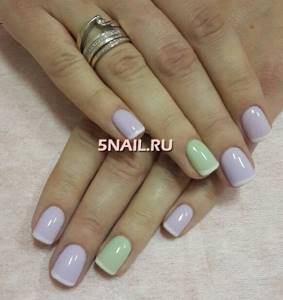
Classic French shellac
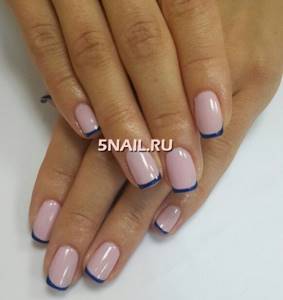
Blue French shellac
When doing French shellac, instead of a paint layer, stick on “smiles” and cover them with a light cream varnish. If desired, use bright and voluminous Cream Puff or noble and calm Stidio White from CND. The palette of these varnishes allows you to choose from dozens of options for a jacket: milky, cream, pink and other shades. Use painting, bouillons and rhinestones, etc. for additional decoration.
Stamping
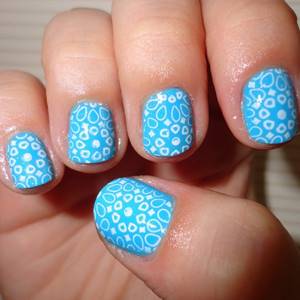
Combination of gel polish with stamping
Stamping is a great simple way to effectively decorate your nails. Shellac or regular varnish – it makes no difference for the stamp. On a high-quality manicure, under the top coat, elegant designs are applied using special varnishes and for stamping. The varnish is applied to a metal plate with a design, the excess layer is removed with a spatula, and then the design is transferred to the nail with a round stamp.
Lunar manicure
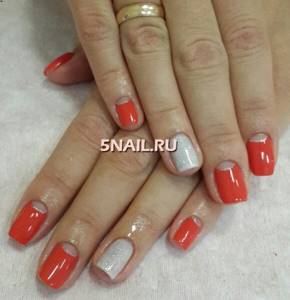
Lunar - smile line near the cuticle
The popular moon manicure is a type of French manicure, only the “smile” is moved closer to the cuticle, and this manicure is usually performed with colored varnishes. The technique of doing it with shellac is no different from French.
Ombre
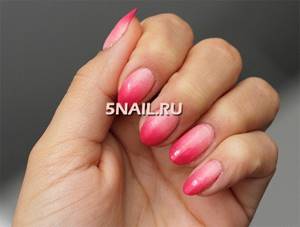
Gradient ombre
Ombre, also known as gradient manicure, is performed using a special brush. The method of performing ombre using a sponge, which is common for classic varnishes, is not suitable for shellac. Therefore, gradient shellac manicure, which is very popular this season, can only be performed by an experienced master, mixing colors directly on the nail plate. One of the colors is applied at the cuticle, and the other at the edge of the nail. Then, using a zero brush, the colors are carefully and evenly mixed. The layer is dried under a lamp and the procedure is repeated.
Water manicure with shellac
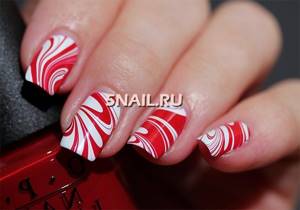
Brightest red pattern. High performance technique.
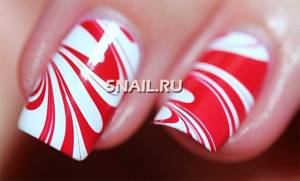
Water manicure close up
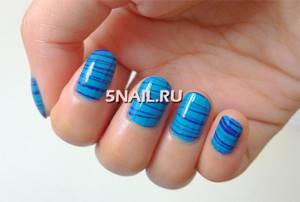
Blue patterns
This type of decoration goes well with shellac technology. After fixing the first paint layer of shellac, you can create designs on your nails using so-called water-based varnishes. For the best effect, use varnishes from the rich CND palette. Paints of selected colors are mixed in water to create abstract patterns and stains. A finger with skin treated with cream or covered with tape is immersed in colorful stains parallel to the water. The design remains on the nail. Then the top coat is applied. This technique requires a lot of dexterity and skill, but is very effective and fashionable this season.
Why we love shellac coating
Shellac is an excellent and very common manicure technique. She practically does not limit the nail art master to any boundaries. Beginners will also be able to realize themselves using modern Shellac materials and technologies, creating a bright and unique nail design.
Shellac manicure is easy to remove on your own, it has a positive effect on the nail plate, does not require deep filing, is compatible with almost any decoration technique and is harmless to health.
We also love shellac because it saves a lot of time, both during the visit and before the next application. But this is provided that you entrust the manicure to a good master: the technique of use is not simple, and has a lot of pitfalls and nuances.
The popular Shellac manicure coating can be done in a salon or yourself. But prices in beauty salons are unreasonably expensive, and learning how to do shellac coating at home requires a lot of patience and a lot of expensive products and materials. Therefore, an experienced manicurist working directly with clients is a compromise and the most optimal option.
How to extend the shelf life of a shellac manicure
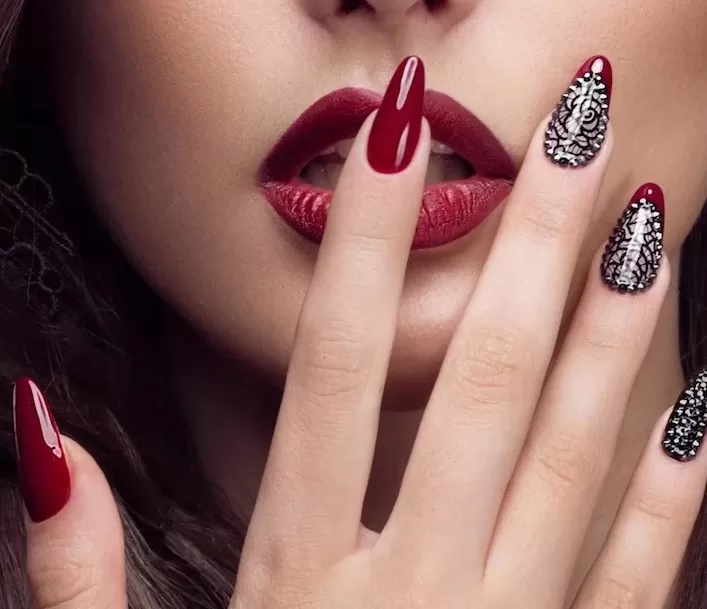
When asking such a question as extending the period of wearing shellac on nails, you need to remember the growth rate of the nail plates. The average person's fingernails grow at a rate of 1-2 millimeters per week. Toenails grow more slowly, growing approximately 0.25-1 millimeter in seven days. It is clear that within a week after the last treatment of the nails and application of the decorative coating, a new area near the cuticle, not painted over with varnish, will appear. It will not look aesthetically pleasing. Therefore, there is no particular need for shellac to last longer than a few weeks at a time. However, there will be little joy in the fact that the coating cracks or peels before the natural need comes and the time to change it comes. Therefore, you can take preventive measures to prevent damage to the integrity of the dense decorative film on the nails:
- Avoid contact of nails with any type of harsh solvents.
- Avoid changes in external temperatures (thermal effects of the hot-cold type).
- Do not test nails and decorative coating for strength. That is, do not scratch or remove hard substances from surfaces unless absolutely necessary.
- Wash dishes, floors, do laundry and perform all other house cleaning activities using rubber gloves, periodically cleaning and airing your hands. The same applies to gardening or other household work.
In principle, no special care is required for a manicure made using shellac. Just protect your nails and hand skin using standard methods, that will be enough.
Why is shellac so popular?
If we talk about Voronezh, shellac is mainly used by beauty salons and nail bars. It is convenient for salons to use this material. Covering time is 30 – 40 minutes. One master in the salon can serve 8–10 clients per day. In nai bars the client norm is even higher, 20 – 30 clients per day.
If you remember that shellac is usually worn for 7-10 days, then it turns out to be a very profitable conveyor belt for salons and nail bars. Today the salon let the client go, and a week later he goes back to the salon to renew his coating. It is not profitable for salons for their specialists to spend 2-2.5 hours working with each client, and for the coating to last at least two weeks. If you do this, the flow of customers will decrease significantly. One master can serve, at best, three clients a day. Clients will go for correction once every two or three weeks.
Salons work on those products that are primarily beneficial to them. They will not tell you that shellac is not suitable for you because you have thin, weakened nails. You will be given a coating, and since you have thin nails, you will be offered additional care products. Naturally for additional money.
Analogues of the original shellac from CND
The standard of quality and efficiency is the products of CND, which was the first to appear on the market, almost 10 years ago. But since 2010, many other large brands have also begun development in this direction, thanks to which products similar to the original shellac are produced by other manufacturers. For example, our consultants recommend products from the following companies:
- In'Garden
– shellac of this brand has all the advantages of CND products. Nail art experts note that the products from this manufacturer thicken more slowly than usual.
- Entity One
– shellac from this company has been developed over many years. Thanks to this, the product is of high quality and can compete with the original. The advantage of shellac from this company is that the material has the property of being smoothly distributed over the surface of the nail and leveling out on its own, like a self-leveling floor, hiding and leveling out all the unevenness of the nail plate. An additional advantage of the product is the optimal shape of the brush, which turns the process of applying varnish into a complete pleasure. One of the disadvantages is the short shelf life of the open drug. Even with increased care in handling, shellac from this company is rarely stored for more than a few months. But it lasts well on nails - three weeks of durability is not uncommon. There are not as many color options as CND - just over a hundred options.
Products from these companies can be easily found among the assortment of large specialized stores. They are more affordable than CND brand products, have the required level of quality, and allow you to perform durable and highly aesthetic nail art that does not harm your nails.
Differences between shellac and other coatings
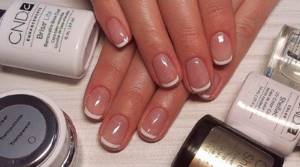
Gel polish, shellac, gel - all these are nail coatings that allow you to get a durable manicure for several weeks without changing color or needing correction.
The main difference between shellac and other materials is the natural resin in its composition, mixed with regular varnish. Similar products from other companies may contain toluenes, formaldehydes and other harmful substances.
There are not many differences between gel polish and shellac. They are very similar in appearance, the technique is identical, but in rare cases a primer is not used under shellac. He should hold up well without it. These materials have more differences with gel. They have different consistencies, application technologies, the gel is not so pliable and requires skill and filing.
Coating properties comparison table
| Shellac | Gel polish | Gel | |
| Package | Bottle with brush | Bottle with brush | Jar with screw cap |
| Consistency | Liquid | Liquid | Thick |
| Application | Brush | Brush | Spatula and brush |
| Nail after drying | Elastic | Elastic | Solid |
| Palette | Rich | Rich | Rich |
| Design | Available | Available | Available |
| Removal | Soaking, filing | Soaking, filing | Mostly sawing |
Shellac or gel
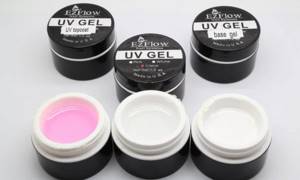
The best thing is that it lasts longer and is more comfortable to wear. Some girls are completely satisfied with shellac; the manicure wears well, looks natural, and the coating allows it to grow to any length. But some nails don’t like it and reject it. Even the masters can’t explain it, they just say “it’s not suitable for everyone.” No matter who makes the coating, the material begins to chip and peel off. In this case, it is better to choose a gel. It will also be a salvation for very thin, bendable nails, since after polymerization it becomes hard.
Shellac or gel polish
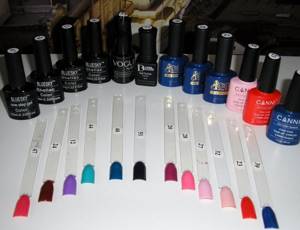
They are very similar in appearance and properties. These materials have virtually no differences in technology. If you learn how to use shellac, you can easily try gel polish. It's difficult to determine which is better. In terms of price, prevalence, and availability, they are ahead of gel polishes. Durability depends on various factors. In terms of composition, shellac has the advantage; it contains less chemicals and dangerous compounds.
Which is more harmful?

For natural nails, incorrect technique, cuts, and sloppy removal are more harmful. With careful work and following all the rules, natural nails become thicker, grow well, and do not require rest, which is talked about so much. Good masters have clients who have beautiful manicures for several years without interruption.
If you approach manicure correctly, the worst thing that can happen is an allergy. If she only uses shellac, then it is better to choose gel or gel polish and vice versa.
The most common myth about long-term coating is that it prevents your nails from breathing. But nails don't need oxygen.
How to understand that using shellac is harmful to your nails
Shellac, like any other manicure product, can harm your nails. Especially if it is used regularly and without long breaks. Or in the case when the body as a whole is weakened, and this is reflected in the condition of the nail plates.
There are several signs that clearly indicate that the use of shellac should be suspended for some time, devoting time to restoring the health of the nails:
- The surface of the nails has become dull and the normal shade of the tissue has changed. They may acquire a yellowish or grayish color.
- Visible defects appeared on the nails - roughness, tubercles, stripes, spots, chips.
- The nails began to exfoliate, their structure was disrupted.
- Negative changes in the skin began around the nail plates. The cuticle thickens, hangnails appear, the skin becomes rough and unpleasant to the touch.
- There was pain in the fingertips.
- Fungal diseases have arisen, which especially often affect the toenails.
Such negative changes can occur for several reasons. For example, if shellac is of poor quality (fake, containing toxic substances, expired product), if the manicurist does not follow the rules for disinfecting accessories and accessories for nail art. If you notice these changes after using shellac, wash the product off your nails and consult a specialist, preferably a mycologist or podologist or therapist.
Pros and cons of shellac
Of the minuses:
- Shellac is only suitable for strong and healthy nails.
- The maximum time without chips and detachments is 14 days. More often 7 – 10 days.
- The material will not adhere to thin and weakened nails.
- Shellac can only be removed by soaking. This dries out the nail plate.
- Cannot be used to repair a cracked nail
- A shellac base will not give your nails an ideal shape.
- Shellac is often counterfeited, so there is a risk of allergies or chemical burns.
Pros:
- Chic color palette
- Quick to apply
In 2010, when CND released Shellac, it took the nail industry by storm. After regular polishes that stayed on nails for 2-3 days, Shellac could be compared to man’s first flight into space, or the release of the first iPhone. I covered my nails with it three or four times. For that money, I paid twice as much as a regular coating, but after a week it was embarrassing to walk around with such nails. I was not happy with the coating. Now my opinion about the material has not changed. Shellac itself has also remained the same since 2010, but additional product lines are released every year.
In my opinion, shellac has more disadvantages than advantages. That's why I don't use it at work. What do you think?
For dessert, a video about a machine that paints your nails itself.
So soon a manicurist will no longer be needed
